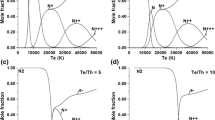Abstract
Argon plasma transport properties at low pressures (0.01 atm) are calculated using a modified Debve length suggested by T. Kihara et al. Electrons and heavy species are treated as two different gases, and the method of calculation is based on the simplified theory (or transport properties developed by R. S. Devoto. A generalized Saha equation is used to calculate the species composition, and experimental data by Y. Itikawa for momentum transfer cross sections are adapted for the evaluation of electron-atom collision cross sections.
Similar content being viewed by others
References
D. Kannappan and T. K. Bose,Phys. Fluids 20, 1668 (1977).
T. K. Bose, D. Kannappan, and R. V. Seeniraj,Wärme Stoffübertragung 19, 3 (1985).
T. K. Bose,Prog. Aerospace Sci. 25, 1 (1988).
R. S. Devoto,Phys. Fluids 10, 2105 (1967).
R. S. Devoto,Phys. Fluids 10, 354 (1967).
R. S. Devoto,Phys. Fluids 16, 616 (1973).
E. J. Miller and S. I. Sandler,Phys. Fluids 16, 491 (1973).
T. Kihara and O. Aono,J. Phys. Soc. Jpn. 18, 837 (1963).
T. Kihara, O. Aono, and Y. Itikawa,J. Phys. Soc. Jpn. 18, 7 (1963).
T. Kihara,J. Phys. Soc. Jpn. 14, 4 (1959).
U. Daybelge,J. Appl. Phys. 41, 2130 (1970).
U. Daybelge,J. Phys. Soc. Jpn. 27, 2463 (1969).
K. C. Hsu, Ph.D. Thesis, Univ. of Minnesota (1982).
S. Veis, “The Saha equation and lowering of ionization energy for two-temperature plasma,” Czechoslovak Conference on Electronics and Vacuum Physics, 4th, Prague (1968), pp. 105–110.
I. O. Hirschfelder, C. F. Curtiss, and R. B. Bird,Molecular Theorv of Gases and Liquids, Wiley, New York (1964).
R. J. Zollweg and R. W. Liebermann,J. Appl. Phys. 62, 3261 (1987):
I. Amdur and E. A. Mason,Phys. Fluids 1, 5 (1958).
A. Dalgarno,Philos. Trans. R. Soc. London 250, 426 (1958).
Y. Itikawa,At. Data Nucl. Data Tables 14, 1 (1974).
P. Rabinowitz,Math. Comput. 13, 285 (1959).
E. A. Mason, R. J. Munn, and F. J. Smith,Phys. Fluids 10, 1827 (1967).
E. V. Samuilov and N. V. Tsitelauri,Teplofiz. Vys. Temp. 7, 1, 108 (1969).
S. C. Lin, E. L. Resler, and A. Kantrowitz,J. Appl. Phys. 26, 95 (1955).
Author information
Authors and Affiliations
Rights and permissions
About this article
Cite this article
Paik, S., Pfender, E. Argon plasma transport properties at reduced pressures. Plasma Chem Plasma Process 10, 291–304 (1990). https://doi.org/10.1007/BF01447132
Received:
Revised:
Issue Date:
DOI: https://doi.org/10.1007/BF01447132




